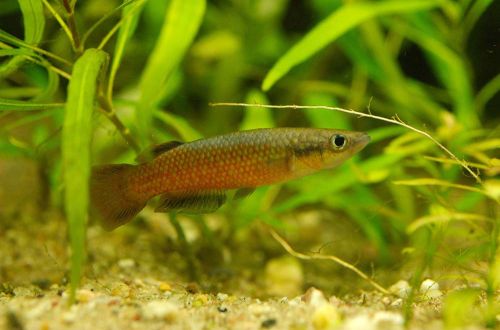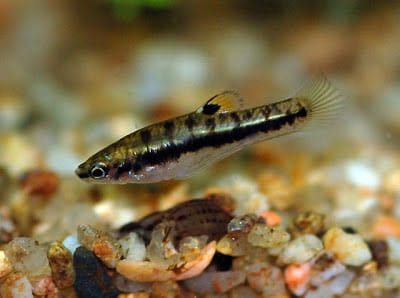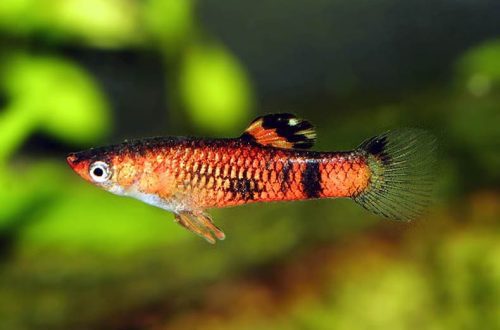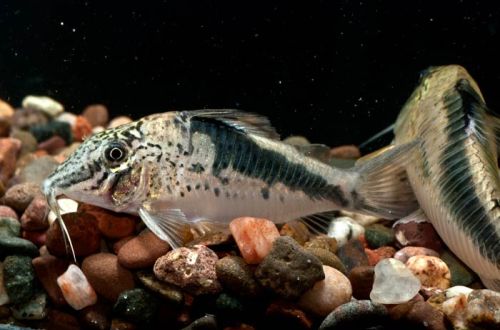
Panchax Omalonotus
Panhax Omalonotus, scientific name Pachypanchax omalonotus, belongs to the Aplocheilidae family. A fairly popular species in the aquarium trade, it has a different color depending on the region of origin, as well as numerous intermediate forms due to cross-breeding. In addition, for a long time there was confusion with another species Panhax Arnu, they were kept together and as a result hybrid offspring appeared.

Contents
Habitat
It comes from the river systems of the islands of Madagascar and Nosy Be (located a little to the north). Stay in the upper or middle reaches of small rivers with a sandy or rocky bottom, flowing in the forest canopy. It is also found in floodplain lakes near the coast.
The population is quite large, the habitat is largely preserved and is not subject to degradation due to human activities, which cannot be said about other water systems of Madagascar.
Description
This species has a pronounced sexual dimorphism. Males are noticeably larger than females, the body length reaches 9 cm, the fins are larger, the colors are more colorful. During the mating season, a dark stripe appears on the body, stretching from head to tail. Females are smaller and modestly painted in gray, silvery color.
Purebred unmixed representatives of Panhax Omalonotus are characterized by color correlation from the region of origin. The color varies from red, yellow to blue. However, hybrid forms are mainly found on sale, where the set of colors is very scarce and is limited mainly to the red spectrum.
Food
In the natural environment, they feed mainly on aquatic and terrestrial insects, small crustaceans and other zooplankton. In the home aquarium, most dry packaged foods (flakes, granules) will be accepted. Important, especially for successful breeding, are additives from live or frozen feed in the form of bloodworms, small worms, daphnia, insects and their larvae (mosquitoes, fruit flies).
Feeding should be carried out 2-3 times a day in the amount eaten in 5 minutes, all uneaten food should be removed.
Maintenance and care
A group of 3-4 fish will require a spacious tank of at least 100 liters. The design combines free areas for swimming with places of dense planting of plants for shelter. Any substrate from sandy to rocky, the selection of soil is carried out primarily based on the needs of plants, not fish.
The minimum set of equipment includes a filtration system, heater, aerator and lighting system. Water parameters do not require special preparation, provided that it is not hard (read more about dGH parameters). It is enough to defend it in an enamel bowl for a day and you can add it to the aquarium. Regular maintenance of the aquarium consists of weekly replacement of part of the water with fresh water (10–15% of the volume) and cleaning of glass and soil from organic waste as necessary.
In general, the maintenance of Panhax Omalonotus does not cause much trouble and is available to almost any aquarist, even with an initial level of experience.
Behavior and Compatibility
Intraspecific relationships are built on the dominance of the alpha male, competing males will regularly fight, but rarely comes to serious physical damage. It is recommended to form a community of one male and several females. The attitude towards other species is tolerant, however, smaller fish may be persecuted.
Breeding / breeding
A fairly simple breeding, no special conditions are required, except for proper nutrition with the inclusion of meat products. Fish can give birth throughout the year, without a clearly defined seasonality. The beginning of the mating season will mark a change in the color of the male, it becomes more saturated and a dark horizontal stripe appears, stretching across the entire body.
Spawning can be carried out in a common aquarium, if other fish species that can eat fry do not live together, otherwise it is recommended to use a spawning tank. Spawning success is largely determined by the safety of eggs. Best survival is achieved with small leaved plants, ferns, mosses such as riccia, java moss, etc. where the fry can take shelter for the first time and feed in safety. Although parents do not show gastronomic interest in their offspring, anything can happen.
Fish diseases
An aquarium with a well-established biological system and a balanced diet do not portend any problems, Panhax is quite hardy, but imbalance promises a lot of trouble. The main cause of most diseases is unsuitable conditions or their significant deterioration. Read more about symptoms and treatments in the Aquarium Fish Diseases section.





